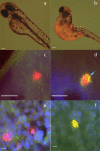Neurotoxicity of the Parkinson Disease-Associated Pesticide Ziram Is Synuclein-Dependent in Zebrafish Embryos
- PMID: 27301718
- PMCID: PMC5089875
- DOI: 10.1289/EHP141
Neurotoxicity of the Parkinson Disease-Associated Pesticide Ziram Is Synuclein-Dependent in Zebrafish Embryos
Abstract
Background: Exposure to the commonly used dithiocarbamate (DTC) pesticides is associated with an increased risk of developing Parkinson disease (PD), although the mechanisms by which they exert their toxicity are not completely understood.
Objective: We studied the mechanisms of ziram's (a DTC fungicide) neurotoxicity in vivo.
Methods: Zebrafish (ZF) embryos were utilized to determine ziram's effects on behavior, neuronal toxicity, and the role of synuclein in its toxicity.
Results: Nanomolar-range concentrations of ziram caused selective loss of dopaminergic (DA) neurons and impaired swimming behavior. Because ziram increases α-synuclein (α-syn) concentrations in rat primary neuronal cultures, we investigated the effect of ziram on ZF γ-synuclein 1 (γ1). ZF express 3 synuclein isoforms, and ZF γ1 appears to be the closest functional homologue to α-syn. We found that recombinant ZF γ1 formed fibrils in vitro, and overexpression of ZF γ1 in ZF embryos led to the formation of neuronal aggregates and neurotoxicity in a manner similar to that of α-syn. Importantly, knockdown of ZF γ1 with morpholinos and disruption of oligomers with the molecular tweezer CLR01 prevented ziram's DA toxicity.
Conclusions: These data show that ziram is selectively toxic to DA neurons in vivo, and this toxicity is synuclein-dependent. These findings have important implications for understanding the mechanisms by which pesticides may cause PD. Citation: Lulla A, Barnhill L, Bitan G, Ivanova MI, Nguyen B, O'Donnell K, Stahl MC, Yamashiro C, Klärner FG, Schrader T, Sagasti A, Bronstein JM. 2016. Neurotoxicity of the Parkinson disease-associated pesticide ziram is synuclein-dependent in zebrafish embryos. Environ Health Perspect 124:1766-1775; http://dx.doi.org/10.1289/EHP141.
Conflict of interest statement
G.B., F.-G.K., and T.S. are co-inventors of U.S. patent no. 8,791,092 and European Patent Application 10 708 075.6, Molecular Tweezers for the Treatment of Amyloid-Related Diseases. The other authors declare they have no actual or potential competing financial interests.
Figures







Similar articles
-
Developmental toxicity of the fungicide ziram in zebrafish (Danio rerio).Chemosphere. 2019 Jan;214:303-313. doi: 10.1016/j.chemosphere.2018.09.105. Epub 2018 Sep 19. Chemosphere. 2019. PMID: 30265938
-
A novel "molecular tweezer" inhibitor of α-synuclein neurotoxicity in vitro and in vivo.Neurotherapeutics. 2012 Apr;9(2):464-76. doi: 10.1007/s13311-012-0105-1. Neurotherapeutics. 2012. PMID: 22373667 Free PMC article.
-
Involvement of the sodium-calcium exchanger 3 (NCX3) in ziram-induced calcium dysregulation and toxicity.Neurotoxicology. 2014 Dec;45:56-66. doi: 10.1016/j.neuro.2014.09.004. Epub 2014 Oct 2. Neurotoxicology. 2014. PMID: 25284465 Free PMC article.
-
Alpha-synuclein and Parkinson's disease.FASEB J. 2004 Apr;18(6):617-26. doi: 10.1096/fj.03-0338rev. FASEB J. 2004. PMID: 15054084 Review.
-
Could a loss of alpha-synuclein function put dopaminergic neurons at risk?J Neurochem. 2004 Jun;89(6):1318-24. doi: 10.1111/j.1471-4159.2004.02423.x. J Neurochem. 2004. PMID: 15189334 Review.
Cited by
-
Zebrafish as a model organism for neurodegenerative disease.Front Mol Neurosci. 2022 Oct 13;15:940484. doi: 10.3389/fnmol.2022.940484. eCollection 2022. Front Mol Neurosci. 2022. PMID: 36311026 Free PMC article. Review.
-
Diesel Exhaust Extract Exposure Induces Neuronal Toxicity by Disrupting Autophagy.Toxicol Sci. 2020 Jul 1;176(1):193-202. doi: 10.1093/toxsci/kfaa055. Toxicol Sci. 2020. PMID: 32298450 Free PMC article.
-
Network analysis of toxic endpoints of fungicides in zebrafish.Toxicol Res (Camb). 2024 Jun 5;13(3):tfae087. doi: 10.1093/toxres/tfae087. eCollection 2024 Jun. Toxicol Res (Camb). 2024. PMID: 38845614 Free PMC article. Review.
-
Comparative study of the effects of ziram and disulfiram on human monocyte-derived macrophage functions and polarization: involvement of zinc.Cell Biol Toxicol. 2021 Jun;37(3):379-400. doi: 10.1007/s10565-020-09540-6. Epub 2020 Jul 25. Cell Biol Toxicol. 2021. PMID: 32712770
-
The delta-opioid receptor and Parkinson's disease.CNS Neurosci Ther. 2018 Dec;24(12):1089-1099. doi: 10.1111/cns.13045. Epub 2018 Aug 3. CNS Neurosci Ther. 2018. PMID: 30076686 Free PMC article. Review.
References
-
- Barnhill LM, Bronstein JM. Pesticides and Parkinson’s disease: is it in your genes? Neurodegener Dis Manag. 2014;4:197–200. - PubMed
MeSH terms
Substances
Grants and funding
LinkOut - more resources
Full Text Sources
Other Literature Sources
Medical
Molecular Biology Databases
Research Materials
Miscellaneous

